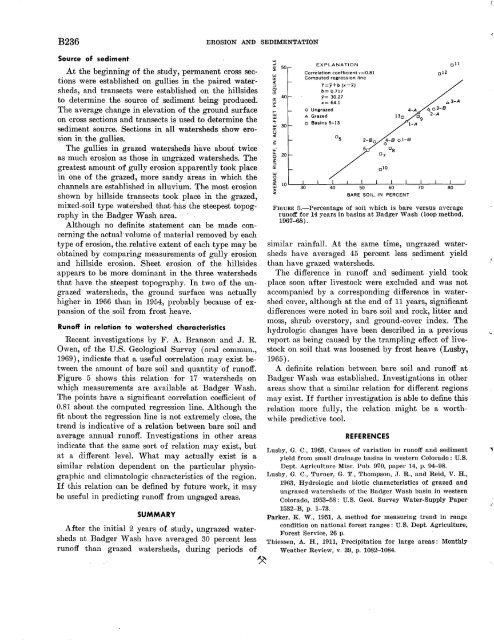RESEARCH· ·1970·
RESEARCH· ·1970·
RESEARCH· ·1970·
You also want an ePaper? Increase the reach of your titles
YUMPU automatically turns print PDFs into web optimized ePapers that Google loves.
B236<br />
EROSION AND SEDIMENTATION<br />
s·ource of sediment<br />
At the beginning of the study, permanent cross sections<br />
were established on gullies in the paired watersheds,<br />
and transects were established on the hillsides<br />
to determine the source of sediment being produced.<br />
The average change in elevation of the ground surface<br />
on cross sections and transects is used to determine the<br />
sediment source. Sections in all watersheds show erosion<br />
in the gullies.<br />
The gullies in grazed watersheds have about' twice<br />
as much erosion as those in ungrazed watersheds. The<br />
greatest amount of gully erosion 'apparently took place<br />
in one of the grazed, more sandy areas in which the<br />
channels are established in alluvium. The most erosion<br />
shown by hillside transects took place in the grazed,<br />
mixed-soil type waJt~rshed· thrut ha:s ·the steepest topography<br />
in the Badger Wash area. ··<br />
Although no definite statement can be made concerning<br />
the actual·volume of material removed by each<br />
type of erosion, the. relative extent of each type may be<br />
obtained by comparing measur.ements. of gully erosion<br />
and hillside erosion. Sheet erosion of the hillsides<br />
appears to be more dominant in the three watersheds<br />
that have the steepest topography. In two of the ungrazed<br />
water~heds, the ground surface was actually<br />
higher in 1966 than in 1954, probably because of expansion<br />
of the soil from frost pea ve.<br />
Runoff in relation to watershed characteristics<br />
Recent investigations by F. A. Branson and J. R.<br />
0\ven, of the U.S. Geologioal Survey (oral commun.,<br />
1969), indicate tJhat ·a useful correlation may exist between<br />
the amount of bare soil and quantity of runoff.<br />
Figure 5 shows this relation for 17 watersheds on<br />
whi9h measurements are available at Badger Wash.<br />
The points have a significant correJlation coefficient of<br />
0.81 about the computed regression line. Although the<br />
fit about the regression line is not extremely close, the<br />
trend is indicative of a relation between bare soil and<br />
average annual runoff. Investigations in other areas<br />
indicate that the same sort of relation may exist, but<br />
at a different level. What may actually exist is a<br />
similar relation dependent on the particular physiographic<br />
and climatologic characteristics of the region.<br />
If this relation can be defined by future work, it may<br />
be useful in predicting runoff from ungaged areas.<br />
SUMMARY<br />
After the initial 2 years of study, ungrazed watersheds<br />
at Badger Wash have averaged 30 percent less<br />
runoff than grazed watersheds, during periods of<br />
~<br />
u.J<br />
..J<br />
~<br />
w<br />
Q:<br />
















